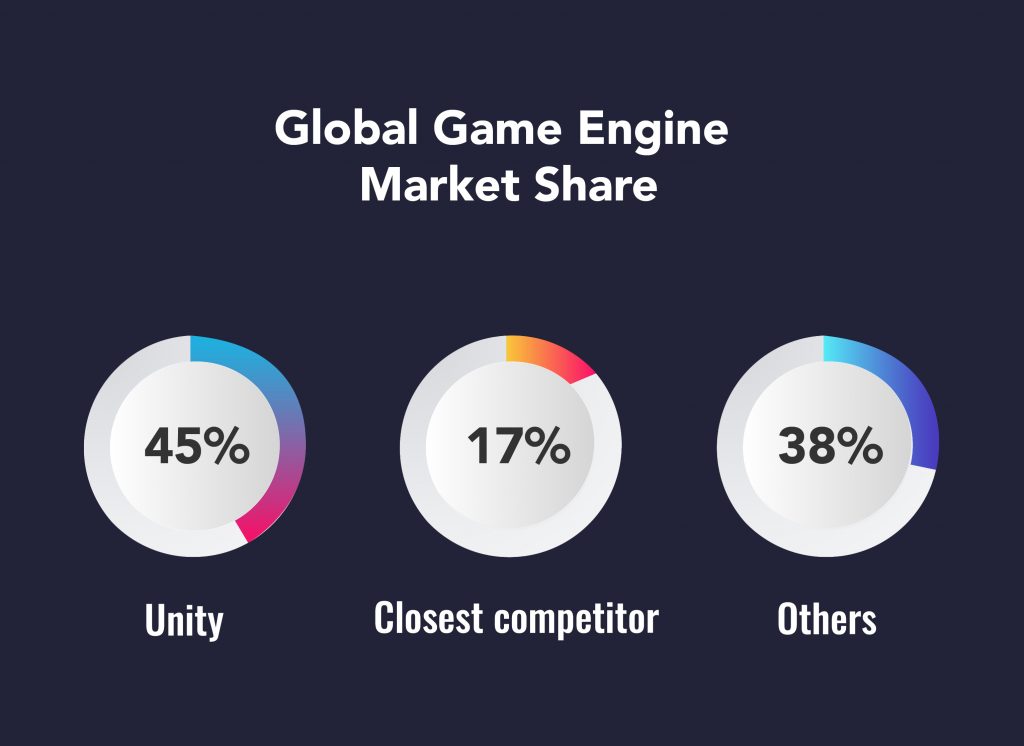Unity 3D has come a long way since its launch in 2005. With its updated version Unity 5, which came with support for dozens of new platforms, major graphic improvements, HD video support, and VR, Unity 3D began cornering the video game development market.
As of 2022, Unity 3D has a market share of 48%, which is 3.5 times more than its direct competitor Unreal Engine. Today, games made with Unity account for 71% of the top thousand titles on the market.
But what makes it unique? Why are most video game developers relying on Unity 3D for game development?
Unity 3D offers game developers greater flexibility when compared to the other game engines in the market. It comes out of the box with support for a wide range of features including 3D graphics rendering, animation, physics simulation, and particle systems — making life easier for video game developers and designers. Apart from these, Unity 3D also offers an integrated development environment (IDE), which includes a real-time editor with built-in debugging tools, as well as an animation system to help developers create their 2D or 3D animations using drag-and-drop functionality.
Before we delve into why video game developers prefer Unity 3D, let’s look at what Unity 3D is and its significance.
What Is Unity 3D & What Is Its Significance?

Unity 3D is a robust cross-platform video game engine developed by Unity Technologies and renowned for its unrivaled cross-platform capabilities. Though Unity has 3D in its name, its application is not limited to developing 3D games. Instead, Unity comes with native support for AR/VR and 2D video game development tools that developers can use to make games in the 3D, 2D, virtual reality, and augmented reality genres, and for creating simulations and other experiences as well.
Apart from these, Unity 3D also comes with native support for features like physics simulation, collision detection, and 3D graphics rendering that can make life easier for video game developers and help them save time spent on developing a video game.

Another prominent feature in Unity 3D is the Asset Store, which is a library of plug-and-play functionalities/animations, uploaded by game developers or designers for fellow members of the video game development fraternity. For instance, say you want to add an immersive burnout effect to the racing game you are building. Instead of building it from scratch, you can search for it on the Asset Store and use it.
Now that we have discussed in brief what Unity 3D is and its core features, let’s see why video game designers mostly rely on Unity 3D for video game development.
7 Benefits of Using Unity 3D for Video Game Development

Here are seven key benefits of using Unity 3D for video game development.
1. An Open-Source Platform
Unity 3D is an open-source platform, and it offers a free version for beginners provided the developed game earns less than $100,000 annually. This free version of Unity 3D is designed exclusively for independent video game developers who have an idea for a new game and are keen on pursuing the idea. For developers who need advanced game development features, Unity 3D offers paid plans named Plus, Pro, Enterprise, and Unity Team.
2. A Comprehensive Gaming Engine
One of the prominent reasons Unity 3D was able to corner the gaming market is because of its comprehensive nature. Unity 3D is a comprehensive package that lets developers develop and deploy a game on the same platform, helping cut down the overhead costs incurred.
3. Intuitive Development Ecosystem
Though Unity 3D comes loaded with dozens of intelligent features, it is far superior when it comes to ease of use compared with other game engines. The game engine is designed to be intuitive so that even an entry-level game developer can leverage the complete functionalities of the platform to build engaging games.
4. Supports Cross-Platform Video Game Development
Unity 3D supports cross-platform and multiplatform game development, saving developers from the hassle of coding individually for every platform. This means that developers will only have to write a single script irrespective of the number of platforms the game will be launched on. When compared to other cross-platform game engines like Unreal Engine, Libed, or Godot Engine, Unity 3D is easy to learn, development-friendly, and faster.
5. Rich Asset Store
The Unity 3D Asset Store is more like a marketplace for gaming assets that developers can download like they download applications from the Play Store or iOS Store. Developers from Unity Technologies and other game developers upload these assets. While most assets are available to developers for free, some advanced assets are not.
In short, the Unity Asset Store will have everything that a developer would need for their game or to build a prototype. These assets include everything from high-quality 3D models to meshes and skeleton low-poly game objects for rapid prototyping.
6. Next-Gen Graphics
Unity 3D relies on the spectrally correct and GPU-accelerated render engine OctaneRender® to create an immersive gaming experience. For example, the popular multiplayer mobile game Call of Duty is built on Unity 3D, and it still ranks top among multiplayer action games due to its magnificent mobile shooter visuals.
7. Easier Debugging
Debugging is the most tiring part of any development project including game development. When compared to other game engines like the Unreal Engine, debugging is easier in Unity 3D as all the variables are displayed in the gameplay during the testing phase. This means that even the less experienced developers can quickly finish debugging.
The 3 Major Limitations of Unity 3D
While Unity 3D comes loaded with intelligent features that make it the favorite of video game developers, it does come with limitations too.
1. Lack of External Code Libraries
The lack of external code libraries on Unity 3D is something experienced game developers have been pointing out for a long time. Owing to this, developers must copy any external library they intend to use for a project. Whereas other game engines permit copying these external libraries to one folder and linking to it while writing code.
2. High Memory Consumption
Games developed on Unity 3D consume more memory than games developed on other engines. Though games built on Unity 3D can run on 2 – 4GB RAM, the games often become choppy after a while, especially when the device heats up. Ideally, games built on Unity 3D would need a minimum of 6GB RAMto to avoid showing out-of-memory (OOM) errors.
3. Lack of Customization of Instance Templates
The instance template is a powerful feature that is exclusive to Unity 3D. Though developers mostly rely on these templates, editing these templates can be tiresome at times.
Why Should You Choose InApp to Be Your Video Game Development Partner?
Backed by a team of expert video game developers, graphic designers, and animators with experience in game engines like Unity 3D and Unreal Engine, InApp can develop mobile/PC/console video games ranging from real-time strategy games to first-person/third-person shooter games, multiplayer games, role-playing games, sports, and action and adventure games.
Contact our team or drop us a line to get a custom quote for your game development project!
Conclusion
Unity 3D is gaining increased popularity in the video game development industry and as of 2021, it was expected to grow at a CAGR of 30%. Although there is competition in the market, Unity 3D is still the preferred game engine of developers because of its intuitiveness and native support for intelligent features.
Frequently Asked Questions
How good is Unity for 3D games?
Packed with native features like physics simulation, collision detection, 3D graphics rendering, and support for AR and VR, Unity 3D works great for creating cross-platform 3D games.
What makes Unity 3D unique?
Unity 3D is a cross-platform capable and comprehensive video game development engine that can manage everything from building characters, simulating character movements, simulating game physics, and rendering and deploying a game. This comprehensive nature of Unity 3D makes it unique.
Is Unity good for learning game development?
Unity 3D is a highly intuitive game development engine and is good for learning game development. If you are new to the world of game development, Unity 3D is the best place to start.
Which are some of the popular games that use Unity?
Monument Valley, Alto’s Adventure, Among Us, Cuphead, and Outer Wilds are some popular games that use Unity.
Which are some of the best programming languages for game development?
The best programming languages for game development depend on project requirements. For versatile and high-performance games, C++ and C# are popular choices. Python excels in simplicity, making it great for beginners and simpler games. JavaScript is essential for web-based games, while Java is relevant for Android development.
Is unity a framework?
No, Unity is not a framework; it’s a full-fledged game development engine. Unity provides a comprehensive set of tools, features, and a visual editor for creating interactive and immersive experiences, including games for various platforms like PC, mobile, and consoles. It includes a rendering engine, physics engine, scripting API, and more. While frameworks typically provide a structure or set of tools for building applications, Unity goes beyond this, offering an integrated environment for game development, encompassing both 2D and 3D game creation.
Is unity or unreal better for beginners?
For beginners, Unity is more beginner-friendly compared to Unreal Engine. Unity has a more straightforward learning curve, a large community, and extensive documentation, making it accessible for those new to game development. Its visual editor is intuitive, and it supports both 2D and 3D game development.
Unreal Engine, while powerful, may have a steeper learning curve due to its advanced features and a more complex visual scripting language (Blueprints). However, Unreal Engine provides stunning graphics and is commonly used for high-end, AAA games.
